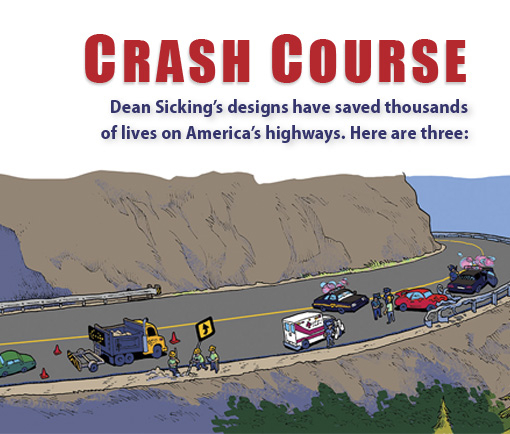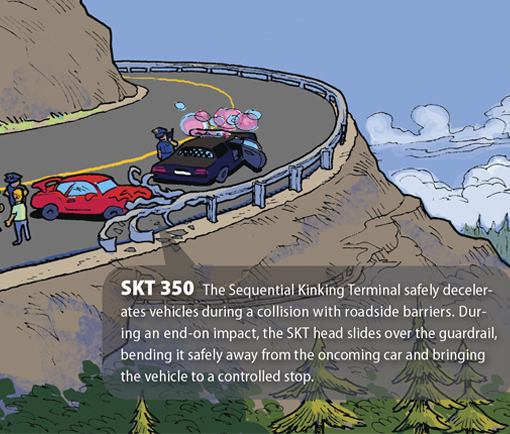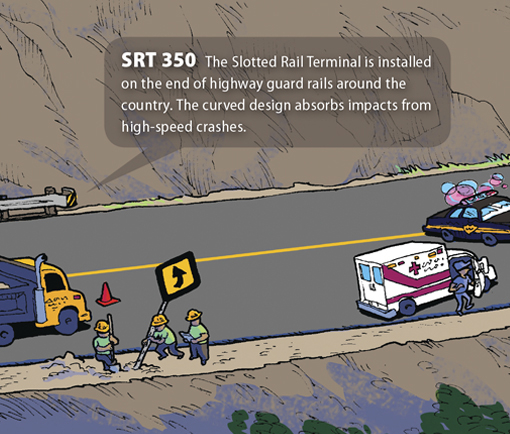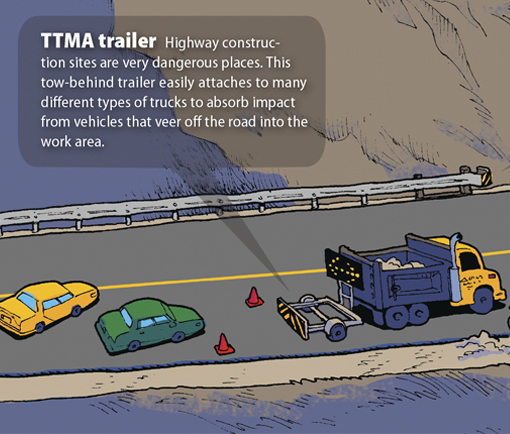By Grant Martin
If you have driven any distance along an Interstate highway in the past couple of decades, you have probably passed the work of UAB engineering professor Dean Sicking, Ph.D. And if you’ve had the misfortune to crash your car along that Interstate—and lived to read this story—it could be that you have Sicking to thank.
For more than 30 years, Sicking has been a leading figure in highway safety research. His designs have reshaped guardrails and other roadside barriers throughout the United States. He was also one of the developers of the Steel and Foam Energy Reduction (SAFER) barriers that are used on NASCAR and Indy Racing League tracks around the world. Last fall, Sicking joined the UAB School of Engineering as a professor and the vice president of product development.
 The SAFER barrier brought renown for Dean Sicking (at Barber Motorsports Park), but his designs have saved lives on roads across America.“Over the years, we have generated dozens of safety devices, to the point where it’s virtually impossible to drive more than a mile on any major freeway in this country without encountering one of our systems,” says Sicking, who spent the past two decades as director of the Nebraska Transportation Center at the University of Nebraska. “Our roadside safety devices save hundreds, if not a thousand, lives per year without getting a whole lot of attention, but when we build a device that saves one or two racecar drivers, everyone wants to know about it.”
The SAFER barrier brought renown for Dean Sicking (at Barber Motorsports Park), but his designs have saved lives on roads across America.“Over the years, we have generated dozens of safety devices, to the point where it’s virtually impossible to drive more than a mile on any major freeway in this country without encountering one of our systems,” says Sicking, who spent the past two decades as director of the Nebraska Transportation Center at the University of Nebraska. “Our roadside safety devices save hundreds, if not a thousand, lives per year without getting a whole lot of attention, but when we build a device that saves one or two racecar drivers, everyone wants to know about it.”
Safe and SAFER
While the disparity in media attention may seem ironic to some, the difference between hearing anecdotal evidence of someone surviving a frightening highway crash and actually watching a racecar driver emerge from a potentially fatal impact is stark. That’s exactly what millions of race fans saw in 2002 when NASCAR driver Kurt Busch crashed into a SAFER-barrier equipped wall at Indianapolis Motor Speedway during the Brickyard 500. “It was a scary crash because the impact with the barrier was on the driver’s-side door,” says Sicking. “Normally that would be very serious, if not fatal, but the fact that he was unhurt was obvious when he immediately climbed out of the car.”
Soon after Busch’s crash, NASCAR installed SAFER barriers at all of its tracks. Since then, there has not been a fatality resulting from an incident with an outer wall barrier in any of NASCAR’s three major series.
Story continues beneath slideshow
The Barber-Blazer Pitch
Thanks in part to the notoriety of SAFER barriers, universities across the nation began recruiting Sicking to their faculties. Although Sicking says UAB was not initially on his radar, a chance meeting with UAB engineering professor David Littlefield, Ph.D., at a conference introduced him to the university. And soon after his first visit to Birmingham, Sicking was hooked. “I loved everything about Birmingham, from the staff at the hotel to the administration and the extremely high level of research being conducted at UAB,” he says.
Another key figure in his recruitment, Sicking says, was George Barber, owner of Barber Motorsports Park in nearby Leeds, Alabama. Barber is building a new state-of-the-art research facility for Sicking at his track. “The facility will be large enough for us to conduct crash tests for a wide variety of research purposes,” he says. “We will have a rail system that will allow us to study the impact of a vehicle hitting a barrier, for example, or we may simulate the effects on dummies inside the vehicle. The impact lab will have a wide range of capabilities, so we just need to generate some research to start utilizing it. The synergy between the university and industry is the kind of collaboration I really want to be a part of.”
Story continues beneath the video
Watch a pickup take on the Sicking-designed SKT 350 guardrail. Video courtesy Road Systems Inc.
More Information
Changing of the Guard
In the 1990s, Dean Sicking wrote the industry standards that the National Cooperative Highway Research Program uses for safety performance evaluation. To do that, he and his team reconstructed 800 high-speed crashes across the American Interstate system. “We selected the 85th percentile impact speed and the 85th percentile impact angle. If you combine those two, it turns out to be the 95th percentile worst-case impact condition. We can’t design all of our safety devices to accommodate the guy who is running from the cops at 100 miles per hour when he crashes, for example. If we did, they would be so expensive that few places could afford them, so a lot of dangerous areas would go unprotected. We made a design that could protect against the worst-case scenarios in the most common accidents at normal highway speeds.”
The first widely used system Sicking developed was an energy-absorbing guardrail terminal—a device that sits over the end of a guardrail, flattening the guardrail when it is hit by a vehicle. The first study of the device showed that out of 400 crashes, there were three injuries and no fatalities—reducing the risk by a factor of 10. But even with detailed research data and real-world results showing the product a success, Sicking says he gets the most satisfaction from a personal testimonial.
“The first time this thing ever got hit was when a young lady was driving home from the library at the University of Texas,” Sicking explains. “She was driving a small pickup truck with her cruise control set at highway speeds when she fell asleep and drifted off the road. She hit the guardrail at 65 or 70 miles per hour, and her only injury was a bruise across her chest caused by the seat belt. I got a very nice letter from her father describing the crash. He felt that she almost certainly would have been killed if she had hit one of the other common guardrail systems, and there is a high probability that he was right. But to hear that from a father whose daughter walked away unhurt—you live for moments like that.”
Despite the success his systems have demonstrated, not everyone is pleased. Sicking describes another letter he received—this one from a highway patrolman—who came upon an accident where the driver got out of his car and started cursing and kicking at the vehicle. When the policeman got closer, he heard the man say, “I can’t even kill myself right.”
“Over the years, I’ve heard of several other police officers who say someone admitted at an accident that they had been trying to commit suicide by hitting one of our systems,” Sicking says. “I think that’s a pretty good testimonial of how effective they can be.”




